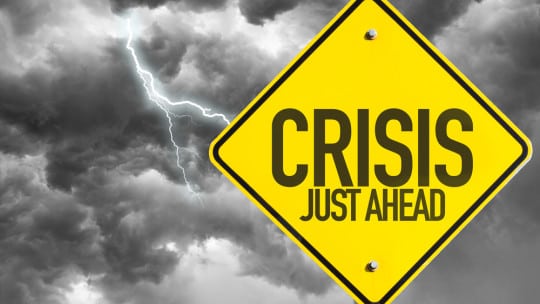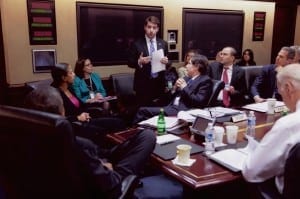
The quality of the screens inside the White House situation room wasn’t much better than on my grandparents’ old television. Images were arranged like The Hollywood Squares. The Central Intelligence Agency appeared in a small box on the upper right-hand side of the screen, the Defense Department next to it and the State Department filled out the top row. Despite the poor resolution, the message that came across was clear. Credible reports said there were mass atrocities in South Sudan. This usually is the point in the film where the president sends in the Marines. Cue 1980s rock music.
The music and the Marines were excluded from this drama. Instead, I found myself baffled by how few tools we seemed to have at our disposal to address a worsening humanitarian situation. There were political costs to putting boots on the ground. United Nations peacekeepers were largely ineffective. Calling the leaders of each side and using strong diplomatic language wasn’t likely to change their calculus. There had to be something more we could do to halt the violence.
Counter-Crisis-Capabilities
I returned to my desk at the National Security Council. There were many other crises demanding attention. The office’s role in this crisis was limited to pushing American officials responsible for international communications to do more. Yet, I couldn’t get this question out of my head: Why didn’t the federal government have more capabilities ready to deploy in this kind of situation?
What if we could change the course of the next crisis before it got out of hand? Speaking with people in and out of government, I came to believe that we were missing our moment of maximum impact. If we pre-constructed some of what I began calling counter-crisis capabilities (CCC), they could be ready when problems started to percolate. We might reduce the frenzy factor, increase our focus, and enhance performance. With the benefit of time, we would also be able to build better Band-Aids or even perhaps more potent medicine to treat the source of the crisis. More about CCC below.
Getting rival factions to lay down their arms or countries not to invade each other may seem far different from the crises a PR team confronts. They’re not.
- First, the nature of crisis is the same, whether it’s local or international.
- Second, stepping back from a situation is one of the best ways to find a solution.
- Finally, risk’s gone regular. What was once a remote possibility now is a very real likelihood. We live in times where change and uncertainty are constants. You must have more than a crisis plan on the shelf.
We need to prepare to be more agile in the face of adversity. In many respects, today’s information environment resembles a battlefield. Our responses need to be ready for this kind of conflict.
Brands That Bend
First, brands need to be more forgivable.Most companies construct a very strong, but rigid public persona. The problem lies in that fact that brands are so strong as to be inflexible. So, when something does go wrong, it inflicts greater damage than if the brand hadn’t held itself up to such high standards.
Consider the case of Chipotle. It was built on being far healthier than any other fast food. It may have overdone it a bit. A fairly standard issue emerged in its supply chain that cracked the strong but stiff structure Chipotle erected to support its pristine public image.
In Mexico City when an earthquake hits, which they do often, the buildings are designed to move with the vibrations. If your brand is too brittle, it will break. Just like the construction across this former capital of the Aztecs, you need to bake in some give to the structure of your client’s reputation. You don’t want to project total perfection since it’s too easy to pierce. Instead, emphasize something more like responsive and resilient.
Shape The Message
If you engage early enough, there often is an opportunity to completely reframe the discussion of the difficulties your brand is facing. Even in the later stages, the frame can be massaged or molded at certain key points. Take the Transportation Security Administration(TSA), for example. Every year a new version of the story emerges about lines growing longer at airports. TSA has done a pretty good job keeping us safe for almost a decade and a half. So why don’t we focus on that more significant story, rather than the fact that to do so, we are spending more time in line?
Get Emotional and get out of the Office
Crises are emotional experiences. Unfortunately, most responses remain formal and fairly cold. This doesn’t work, especially in the hypersensitive age of social media. Forget standard terms such as “we are concerned,” “regret” or “will carefully review.” When choosing your words, find those that will resonate on a more emotional level. How would you speak to your family if a crisis had touched it? Then, don’t just write it down. Get out from your offices and deliver it, engage, and ideally do something beyond what would be expected.
Find the Future
Amidst the frenzy of crisis we often forget to find the future. No matter how bad the damage, there’s always a future to be found. If you leave it to others, it may take a while. One of the most important roles you can play when confronting a crisis is accelerating its arrival. The first step toward the next story is internally accepting, publicly acknowledging and quickly acting at the initial signs of friction.
As Hillary Clinton’s challenges with email so painfully demonstrated, failure to fully acknowledge and address an issue only prolongs the problem—sometimes with devastating consequences. Once you have completely and convincingly satisfied the stage of response, pivot to the positive.
Change the Focus

It helps to have an alternative to adversity—a program, a plan or some plausible possibility of what can be done to move beyond the problem. Again, ideally this is prepared well ahead of time.
The most important form of future finding involves countermeasures. Plotting their introduction is tricky. It can’t be so dissimilar from the issue at hand so as to be dismissed as a distraction. Instead, it should be seen as a logical evolution, linked to the initial issue. Essential is its ability to capture the public’s, the pundits’ or their problematic consumers’ imaginations. This shouldn’t be a dull, technical or complicated concept. You want to be able to quickly, credibly and captivatingly roll it out.
Starbucks killed Christmas. The brand was pilloried as the modern embodiment of the Grinch for the red cup scandal. The company removed Christmas references and imagery from its red holiday cups. A crisis was brewing, pardon the expression. Yet, the same day, the company announced it would extend its free college education program to children of veteran employees.
While it may not have been designed as a countermeasure to crisis, it played the same role. Stories about red cups dissipated as Starbucks reinforced its image as a company committed to noble causes. It even produced collectable cups that read, “Serving those who serve.” Remember, anything you can do to make commitments concrete goes a long way. Whatever you choose, your efforts to find the future ideally makes those still focused on the problems of the past look like they’re obstructing progress.
We have to find a better way to manage risk. We need to abandon the outdated notion that by battening down the hatches or hopping in a lifeboat we can weather the storms. Running and hiding is no longer a viable option for most brands. Getting ready for regular risk requires brands to be more adaptive, agile and able to engage effectively in moments of maximum danger.
After the frustrating experience of working on the civil war in South Sudan, I developed an approach for the U.S. Government that I alluded to above, CCC. It ultimately went into the president’s budget guidance for all federal agencies. CCC directed agencies to build ahead of time the response tools they needed for key global threats. It wasn’t going to create institutional change overnight. Yet it was a strong signal that the nature of crisis was evolving at an unprecedented speed and scale and that structures needed to adapt.
The early results were encouraging. CCC tactics successfully pushed back against Russian propaganda in Ukraine and started a global movement in response to the kidnappings of the schoolgirls in Nigeria.
CONTACT: [email protected]
